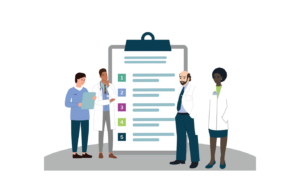5 Creative Ways to Retain Healthcare Workers
By Blakely Roth | September 18, 2024
Healthcare practices continue to grapple with a never-ending staffing crisis. With rising patient demand, many practices are scrambling to find qualified personnel, yet the candidate pool is extremely limited, making hiring a challenge. Amplifying this staffing shortage, existing employees are stretched too thin – leading to healthcare worker stress, burnout and higher turnover. This is where the cycle repeats, as turnover necessitates rehiring.
In a recent poll, 88% of healthcare executives reported difficulty hiring medical staff. Another survey found nearly 56% of medical groups report staffing as their biggest productivity roadblock. It’s time to make a change.
Fight Back with Patient-Led Automation That Reduces Staff Burdens
Hiring and staff retention challenges affect not only care providers but also front desk workers. A shortage in these roles can significantly disrupt the patient experience and hinder practice growth.
High-growth practices are leaning into proven digital patient-led tools that automate menial or time-consuming tasks, dropping staff workloads to reduce burnout while ensuring productivity and efficiency with their existing workforce. Here are five areas high-growth practices are using automation to break the cycle of churn and rehiring:
1. Online scheduling:
When practices rely solely on phone scheduling, front desk staff become overwhelmed with this single task, leaving them with limited time for patient interaction and other important responsibilities. Implement digital self-scheduling solutions to enable patients to book appointments online at any time. This solution reduces phone traffic and allows staff to focus on patient care and other value-adding activities – increasing employee satisfaction and retention rates.
Patient self-scheduling tools have other practice-changing benefits, too! They help you meet patient demand and 82% of patients prefer a provider who offers online scheduling. Practices have saved 500+ hours in a year by offering online scheduling while increasing monthly patient visits by 174%! Not only are practices saving time and filling schedules, but they’ve also increased booking accuracy with smart, scheduling logic!
Noitavia Fitts, Senior Manager of Patient Experience at a growing practice shared, “Self-scheduling has made a positive impact on the way we take care of patients. We are dropping our abandoned booking rates, meeting patient expectations and acquiring a good percentage of new patients every day. What truly helped us was the customization of our self-scheduling workflows. Now we can stay competitive and alleviate staff burdens around scheduling management.”
2. Pre-registration and clinical intake:
Practices can encourage patients to pre-register ahead of their appointments by adding the link to their reminder commuications. When patients click the link, they are prompted to fill out all the necessary demographic and medical history information, scan their ID and insurance cards and even sign consents. All forms and information captured during the pre-registration process are automatically reconciled and integrated into your PMS/EHR, which means no staff involvement!
Patients no longer need to arrive at their appointment 20 minutes early to fill out a stack of paperwork and staff members no longer need to make paper copies, scan licenses and insurance cards, or devote time to data entry. It’s a win-win for staff and patients, and from a practice perspective, electronic data entry also results in better accuracy for cleaner claims!
3. Patient-led check-in:
Pre-registration and check-in go hand-in-hand. When all necessary patient information and digital consents are submitted ahead of time, check-in becomes significantly easier and faster. However, requiring patients to check-in with a front desk worker can still add time to the process, however. To truly make check-in quick and easy for staff and patients, high-growth practices are implementing next-generation check-in kiosks. Patients simply enter the office, walk up to the kiosk and check in – and the process is done in under two minutes. Patients love this feature – practices see 99% patient adoption of self-service kiosks, which nearly eliminates staff involvement in check-in. Some practices are even dropping required staff by 60%, reallocating those employees to other areas of operations.
4. Point-of-service collections:
In a busy office, staff may feel uncomfortable or too rushed to ask for payment. Yet, when outstanding balances or co-pays aren’t collected upfront, many times, administrative workers end up trying to track down these payments on the back end. Front desk employees are not bill collectors, so financial responsibilities can leave them feeling frustrated. Additionally, considering the fact that the probability of receiving payment after a patient leaves the office is 30%, manual collections can often result in lost revenue for your practice.
Rather than rely on staff, collect payments digitally at the point-of-service and even enable patients to keep a card-on-file for future transactions. During patient check-in, digital tools can discreetly display co-pays and open balances and then prompt the patient to pay then and there. Automating payment collections in this way saves hours and hours of traditional staff workload, and practices have seen upward of 112% increases in collection rates!
5. Automated appointment reminders:
Let’s face it…employees don’t like making appointment reminder phone calls and many patients neglect to answer them. In the digital age, automating the process and connecting with patients on their level is preferable and much more efficient. Smart patient communications tools allow you to do just this by sending automated appointment reminders using the best notification type for different patient demographics. With the right solution you can drop your no-show rate to just under 4% or lower — and your providers will take notice!
One CEO shares how they use their reminder to keep appointment slots filled and reduce no-shows – all while eliminating the endless hours of staff work. Watch the quick clip here.
Real Results for Higher Profits and Happier Staff in 2024
Automating key processes in the patient journey can reduce staff workloads–by up to 87%–helping practices keep patients happy despite the ongoing staffing shortage. Metrolina Eye Associates is a great example of how you can successfully run an efficiency practice while reducing staff burdens and improve patient reviews. After implementing self-registration kiosks, Metrolina Eye Associates saw a 50% drop in check-in times and a nearly 40% increase in collection rates at the point-of-service. See how this growing practice made it happen!
Recommended for you
Related Posts
Pros and Cons of Self-Service Kiosks in Healthcare
Reading Time: 6 minutesBy Chloe From Clearwave | March 24, 2025 Considering the pros and cons of self-service kiosks for your healthcare practice?…
Instant Revenue Impacts for Southview Medical Group
Reading Time: 3 minutesBy Blakely Roth, March 20, 2025 Southview Medical Group, a multi-specialty healthcare organization, serves over 700 patients daily across various…
Clearwave Announces 2024 clearwaveCup Winners, Celebrating Excellence in Patient Engagement
Reading Time: 3 minutesATLANTA – February 25, 2025 – Clearwave, the patient-led self-service solution provider, is proud to announce the recipients of the…




